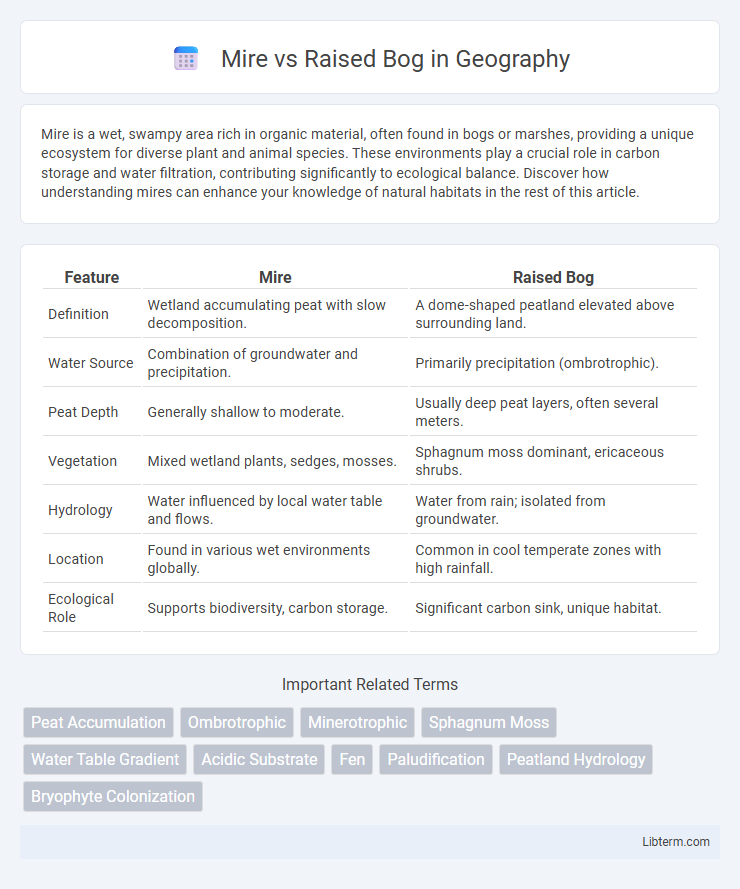Mire is a wet, swampy area rich in organic material, often found in bogs or marshes, providing a unique ecosystem for diverse plant and animal species. These environments play a crucial role in carbon storage and water filtration, contributing significantly to ecological balance. Discover how understanding mires can enhance your knowledge of natural habitats in the rest of this article.
Table of Comparison
| Feature | Mire | Raised Bog |
|---|---|---|
| Definition | Wetland accumulating peat with slow decomposition. | A dome-shaped peatland elevated above surrounding land. |
| Water Source | Combination of groundwater and precipitation. | Primarily precipitation (ombrotrophic). |
| Peat Depth | Generally shallow to moderate. | Usually deep peat layers, often several meters. |
| Vegetation | Mixed wetland plants, sedges, mosses. | Sphagnum moss dominant, ericaceous shrubs. |
| Hydrology | Water influenced by local water table and flows. | Water from rain; isolated from groundwater. |
| Location | Found in various wet environments globally. | Common in cool temperate zones with high rainfall. |
| Ecological Role | Supports biodiversity, carbon storage. | Significant carbon sink, unique habitat. |
Introduction to Mire and Raised Bog
A mire is a type of wetland ecosystem characterized by the accumulation of organic matter, primarily peat, in waterlogged conditions where decomposition rates are slower than accumulation. Raised bogs are a specific subtype of mires that develop a dome-shaped peat layer elevated above the surrounding landscape, receiving most of their water from precipitation rather than groundwater. These bogs play a crucial role in carbon sequestration, biodiversity support, and hydrological regulation in temperate and boreal regions.
Definition and Characteristics of Mires
Mires are a type of wetland ecosystem characterized by the accumulation of peat due to slow decomposition of organic matter in water-saturated conditions. They exhibit distinct hydrological and ecological properties, with waterlogged soils that support specialized plant species such as Sphagnum mosses. Raised bogs are a subtype of mires distinguished by their dome-shaped peat surface that rises above the surrounding landscape, primarily fed by precipitation rather than groundwater.
What is a Raised Bog?
A raised bog is a type of mire characterized by a dome-shaped accumulation of peat that rises above the surrounding landscape, formed primarily from sphagnum mosses in waterlogged, acidic conditions. It develops over thousands of years through slow peat accumulation in nutrient-poor environments, resulting in a highly specialized wetland ecosystem. Raised bogs play a crucial role in carbon storage, biodiversity conservation, and water regulation.
Formation Processes: Mire vs Raised Bog
Mires form through the accumulation of partially decomposed organic matter in waterlogged conditions with limited oxygen, often developing in various topographic settings such as lowlands or depressions. Raised bogs specifically develop from mires over time as peat accumulation elevates the bog surface above the surrounding landscape, relying primarily on precipitation for water and nutrients. The shift from a general mire to a raised bog involves hydrological isolation, peat dome formation, and a transition to ombrotrophic conditions, where nutrient input is minimal and acidity is high.
Hydrology Differences
Mires and raised bogs differ significantly in hydrology, with mires often characterized by waterlogged soils maintained through surface water input and groundwater influence. Raised bogs, however, depend primarily on precipitation for water, resulting in nutrient-poor, acidic conditions due to the limited mineral input. The distinct hydrological regimes influence peat accumulation, vegetation types, and ecosystem functions unique to each wetland type.
Vegetation and Biodiversity
Mires exhibit a diverse range of vegetation dominated by sphagnum mosses, sedges, and specialized shrubs, creating unique acidic and waterlogged conditions that support rare plant species and specialized fauna. Raised bogs, a type of mire, feature a domed surface with peat accumulation and are primarily vegetated by sphagnum mosses, ericaceous shrubs, and sparse trees, fostering habitats for distinctive bog-adapted species such as cranberries and carnivorous plants. Both ecosystems provide critical biodiversity hotspots by maintaining hydrological conditions essential for rare invertebrates, amphibians, and bird species adapted to nutrient-poor, acidic environments.
Geographical Distribution
Mires and raised bogs are predominantly found in cool, temperate regions of the Northern Hemisphere, with significant concentrations in northern Europe, Canada, Russia, and parts of Scandinavia. Raised bogs specifically develop in lowland areas with poor drainage, leading to the accumulation of peat layers that elevate the bog surface above the surrounding landscape. Geographic distribution reflects climatic conditions that support waterlogged soils and slow decomposition, essential for peat formation in both mires and raised bogs.
Ecological Importance and Functions
Mires and raised bogs play critical roles in carbon sequestration, storing vast amounts of organic carbon and mitigating climate change. These ecosystems provide unique habitats for specialized plant and animal species, supporting biodiversity and maintaining hydrological balance by regulating water flow and purifying groundwater. Their ability to accumulate peat over millennia makes them significant natural archives for paleoecological research and climate history.
Threats and Conservation Status
Mires, including raised bogs, face significant threats from peat extraction, drainage for agriculture, and afforestation, leading to habitat degradation and carbon release. Raised bogs, characterized by their dome-shaped peat accumulation, are particularly vulnerable due to their slow regeneration rate and sensitivity to hydrological changes. Conservation efforts prioritize restoration of natural water regimes and legal protection under frameworks such as the Ramsar Convention and EU Habitats Directive to preserve biodiversity and carbon storage functions.
Key Differences: Mire vs Raised Bog
Mires are a broad category of peat-forming wetlands characterized by waterlogged conditions and the accumulation of organic matter, while raised bogs are a specific type of mire with a dome-shaped peat deposit elevated above the surrounding landscape. Raised bogs receive water primarily from precipitation rather than groundwater, resulting in nutrient-poor, acidic conditions that influence distinct plant communities dominated by Sphagnum mosses. The key differences lie in hydrology, topography, and nutrient sources, with raised bogs representing a specialized, ombrotrophic subtype of mires.
Mire Infographic

 libterm.com
libterm.com